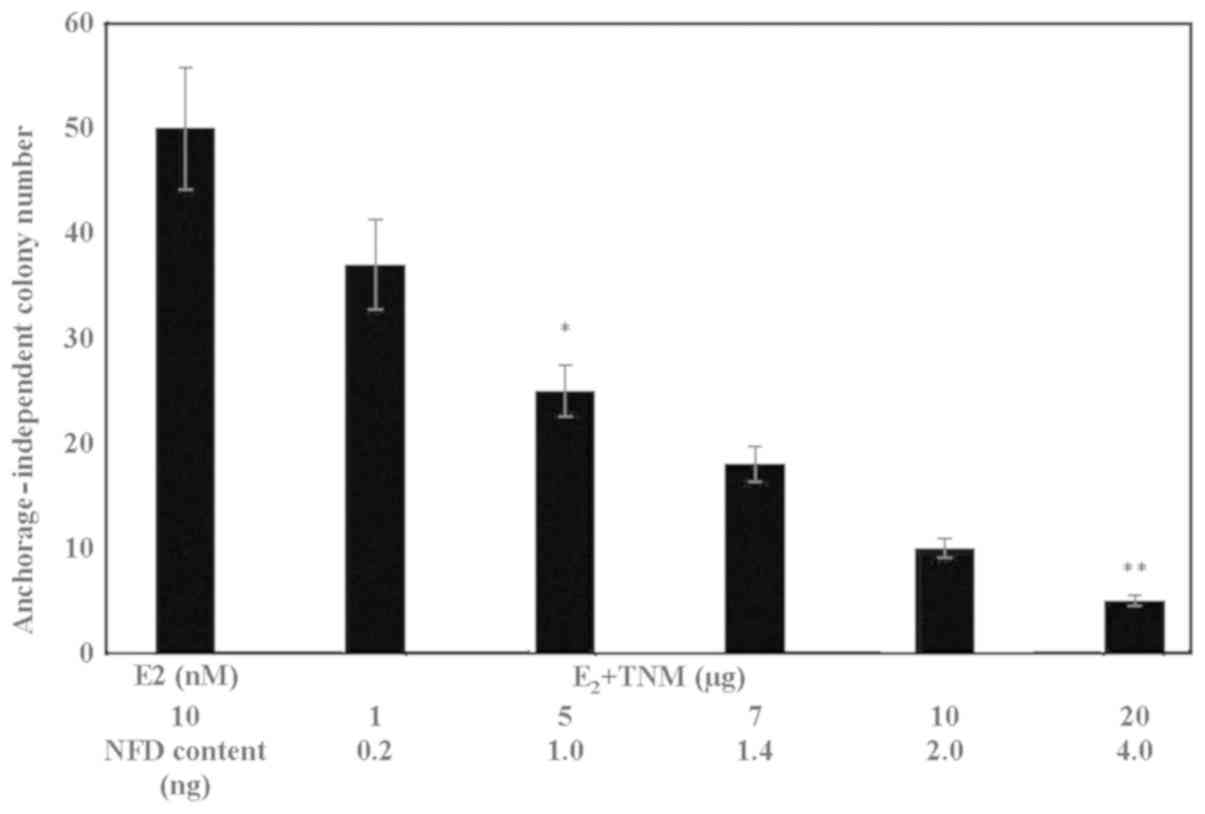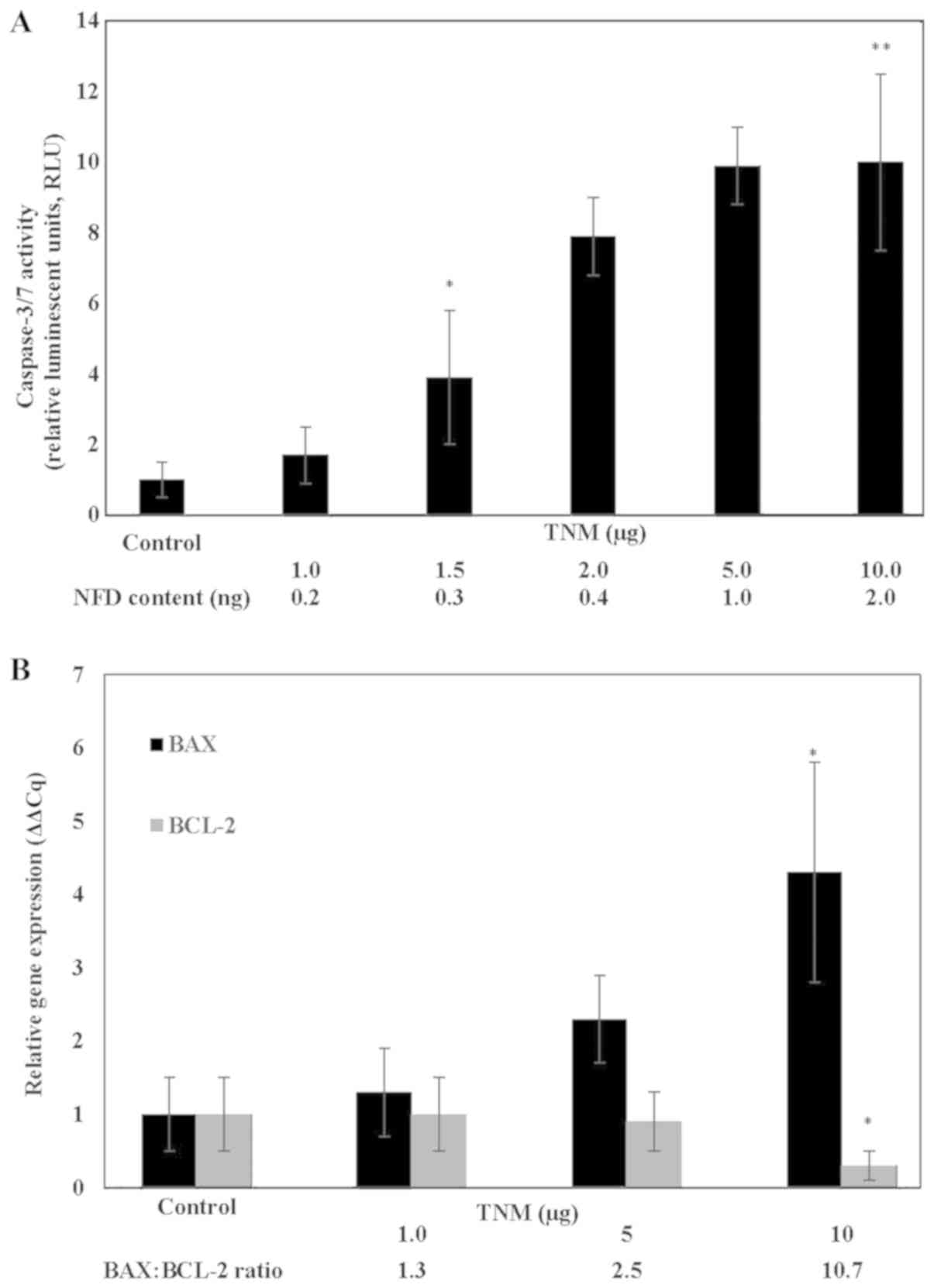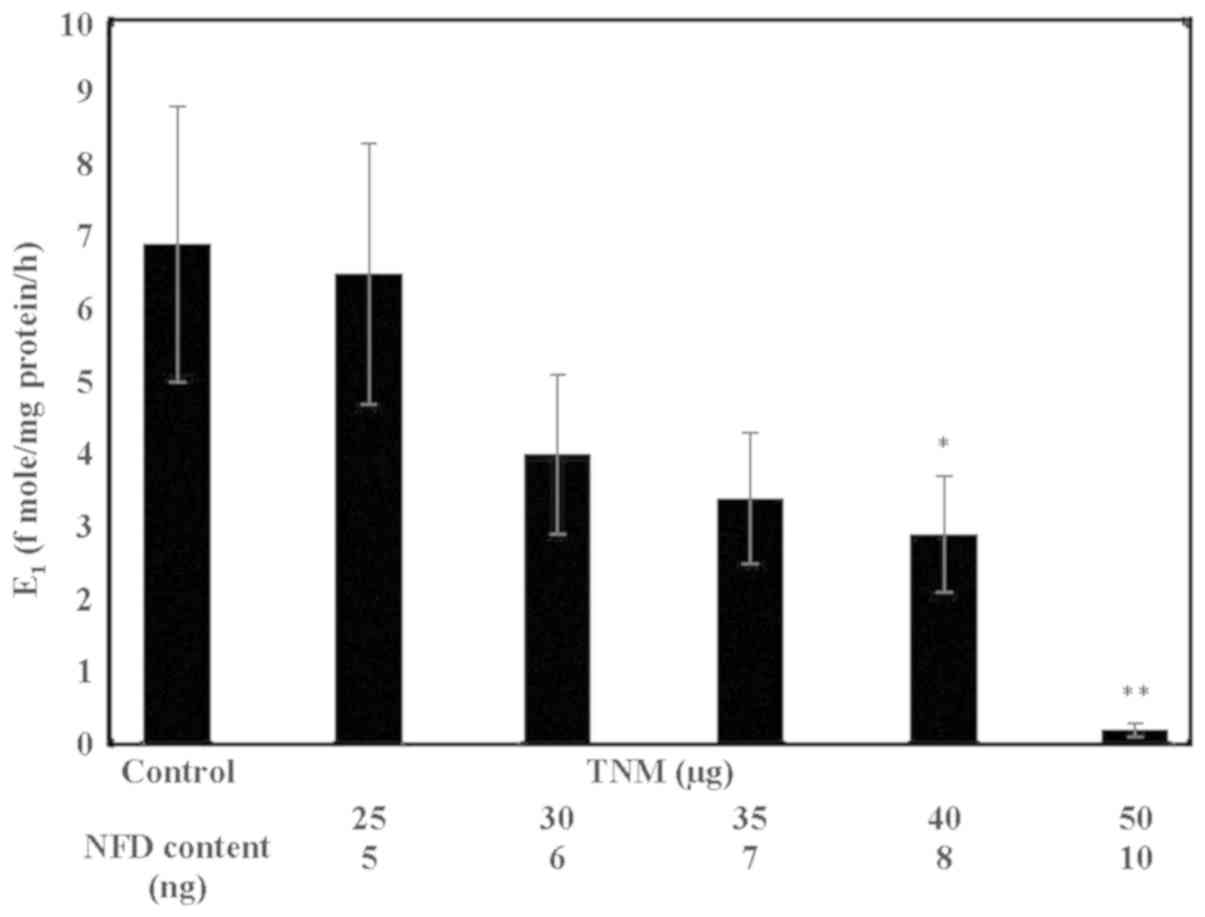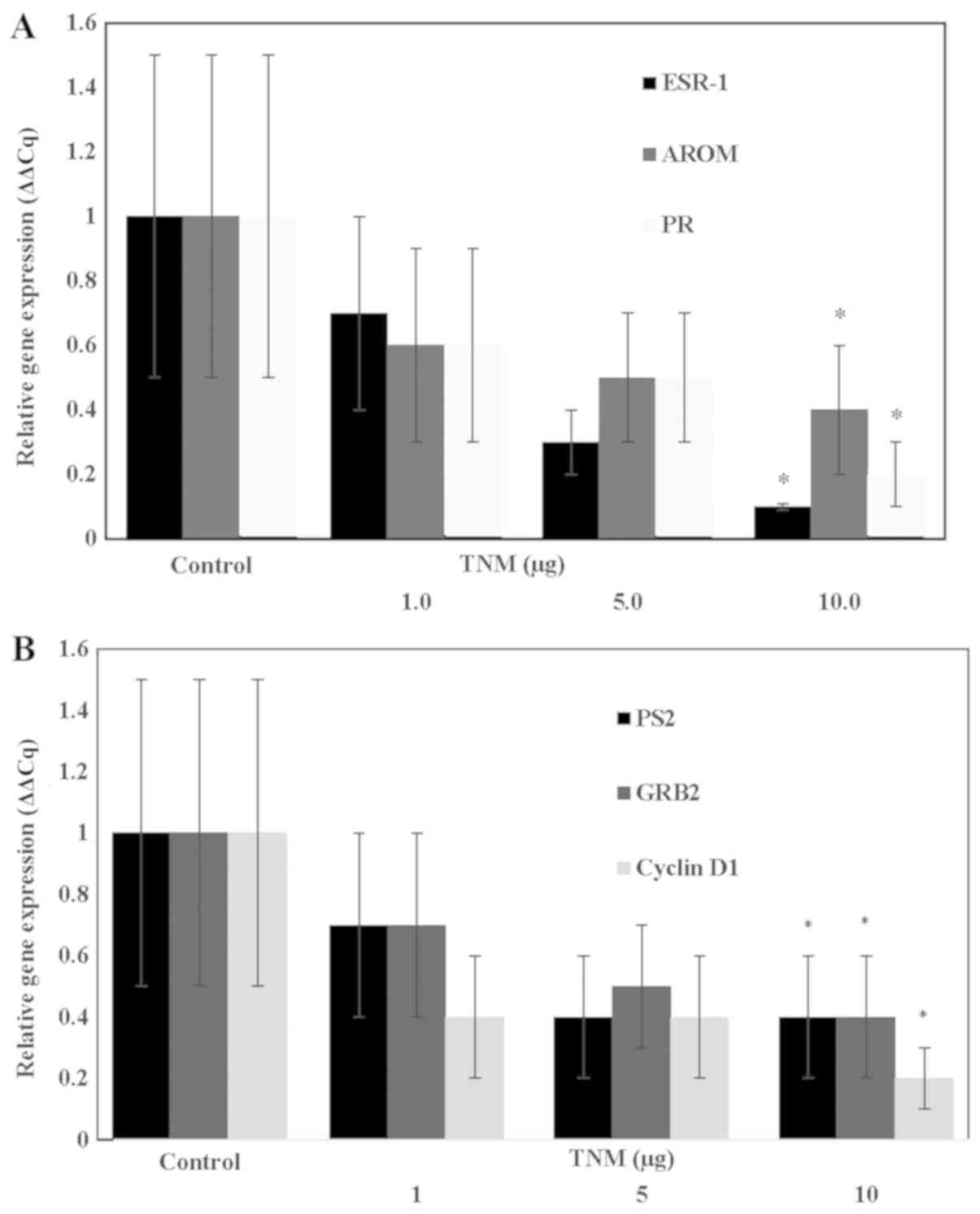|
1
|
Johnston SRD and Dowsett M: Aromatase
inhibitors for breast cancer: Lessons from the laboratory. Nat Rev
Cancer. 3:821–831. 2003.PubMed/NCBI View
Article : Google Scholar
|
|
2
|
Ali S and Coombes RC: Endocrine-responsive
breast cancer and strategies for combating resistance. Nat Rev
Cancer. 2:101–112. 2002.PubMed/NCBI View
Article : Google Scholar
|
|
3
|
Ma CX, Reinert T, Chmielewska I and Ellis
MJ: Mechanisms of aromatase inhibitor resistance. Nat Rev Cancer.
15:261–275. 2015.PubMed/NCBI View
Article : Google Scholar
|
|
4
|
Ma CK, Gao F, Luo J, Northfeld DW, Goetz
M, Forero A, Hoog J, Naughton M, Ademuyiwa F, Suresh R, et al:
NeoPalAna: Neoadjuvant Palbociclib, a cyclin-dependent kinase 4/6
inhibitor, and Anastrozole for clinical stage 2 or 3 estrogen
receptor- positive breast cancer. Clin Cancer Res. 23:4055–4065.
2017.PubMed/NCBI View Article : Google Scholar
|
|
5
|
Taglieri L, De Iuliis F, Giuffrida A,
Giantulli S, Silvestri I and Scarpa S: Resistance to the mTOR
inhibitor everolimus is reversed by the downregulation of survivin
in breast cancer cells. Oncol Lett. 14:3832–3838. 2017.PubMed/NCBI View Article : Google Scholar
|
|
6
|
Brodie A, Jelovac D and Long BJ:
Predictions from a preclinical model: Studies of aromatase
inhibitors and antiestrogens. Clin Cancer Res. 9:455S–459S.
2003.PubMed/NCBI
|
|
7
|
Boér K: Impact of palbociclib combinations
on treatment of advanced estrogen receptor-positive/human epidermal
growth factor 2-negative breast cancer. OncoTargets Ther.
9:6119–6125. 2016.PubMed/NCBI View Article : Google Scholar
|
|
8
|
Alves CL, Elias D, Lyng M, Bak M,
Kirkegaard T, Lykkesfeldt AE and Ditzel HJ: High CDK6 protects
cells from Fulvestrant-mediated apoptosis and is predictor of
resistance to Fulvestrant in estrogen receptor-positive metastatic
breast cancer. Clin Cancer Res. 22:5514–5526. 2016.PubMed/NCBI View Article : Google Scholar
|
|
9
|
Hole S, Pedersen AM, Hansen SK, Lundqvist
J, Yde CW and Lykkesfeldt AE: New cell culture model for aromatase
inhibitor-resistant breast cancer shows sensitivity to fulvestrant
treatment and cross-resistance between letrozole and exemestane.
Int J Oncol. 46:1481–1490. 2015.PubMed/NCBI View Article : Google Scholar
|
|
10
|
Sabnis G and Brodie A: Understanding
resistance to endocrine agents: Molecular mechanisms and potential
for intervention. Clin Breast Cancer. 10:E6–E15. 2010.PubMed/NCBI View Article : Google Scholar
|
|
11
|
Moy B and Goss PE: Estrogen receptor
pathway: Resistance to endocrine therapy and new therapeutic
approaches. Clin Cancer Res. 12:4790–4793. 2006.PubMed/NCBI View Article : Google Scholar
|
|
12
|
O'Hara J, Vareslija D, McBryan J, Bane F,
Tibbitts P, Byrne C, Conroy RM, Hao Y, Gaora PO, Hill ADK, et al:
AIB1:ERα transcriptional activity is selectively enhanced in
aromatase inhibitor-resistant breast cancer cells. Clin Cancer Res.
18:3305–3315. 2012.PubMed/NCBI View Article : Google Scholar
|
|
13
|
Ebina T: Anti-tumor effect of hot water
extract of Taheebo tea: Comparison with other biological
preparations. Biotherapy. 16:321–327. 2002.
|
|
14
|
Brisson M, Nguyen T, Vogt A, Yalowich J,
Giorgianni A, Tobi D, Bahar I, Stephenson CR, Wipf P and Lazo JS:
Discovery and characterization of novel small molecule inhibitors
of human Cdc25B dual specificity phosphatase. Mol Pharmacol.
66:824–833. 2004.PubMed/NCBI View Article : Google Scholar
|
|
15
|
Choi YH, Kang HS and Yoo MA: Suppression
of human prostate cancer cell growth by β-lapachone via
down-regulation of pRB phosphorylation and induction of Cdk
inhibitor p21 (WAF1/CIP1). J Biochem Mol Biol. 36:223–229.
2003.PubMed/NCBI
|
|
16
|
Lee JH, Cheong J, Park YM and Choi YH:
Down-regulation of cyclooxygenase-2 and telomerase activity by
β-lapachone in human prostate carcinoma cells. Pharmacol Res.
51:553–560. 2005.PubMed/NCBI View Article : Google Scholar
|
|
17
|
Mukherjee B, Telang N and Wong GYC: Growth
inhibition of estrogen receptor positive human breast cancer cells
by Taheebo from the inner bark of Tabebuia avellanedae tree.
Int J Mol Med. 24:253–260. 2009.PubMed/NCBI View Article : Google Scholar
|
|
18
|
Telang NT, Nair HB and Wong GYC: Efficacy
of Tabebuia avellanedae extract on a cell culture model for
triple negative breast cancer. Cancer Res. 74 (Suppl):SABCS,
P5-14-02. 2014.
|
|
19
|
Liu YG, Tekmal RR, Binkley PA, Nair HB,
Schenken RS and Kirma NB: Induction of endometrial epithelial cell
invasion and c-fms expression by transforming growth factor β. Mol
Hum Reprod. 15:665–673. 2009.PubMed/NCBI View Article : Google Scholar
|
|
20
|
Livak KJ and Schmittgen TD: Analysis of
relative gene expression data using real-time quantitative PCR and
the 2-ΔΔCT method. Methods. 25:402–408. 2001.PubMed/NCBI View Article : Google Scholar
|
|
21
|
Nair HB, Luthra R, Kirma N, Liu YG,
Flowers L, Evans D and Tekmal RR: Induction of aromatase expression
in cervical carcinomas: Effects of endogenous estrogen on cervical
cancer cell proliferation. Cancer Res. 65:11164–11173.
2005.PubMed/NCBI View Article : Google Scholar
|
|
22
|
American Cancer Society: Cancer facts and
figures. American Cancer Society, Atlanta, GA, 2018.
|
|
23
|
Gupta A, Mehta R, Alimirah F, Peng X,
Murillo G, Wiehle R and Mehta RG: Efficacy and mechanism of action
of Proellex, an antiprogestin in aromatase overexpressing and
Letrozole resistant T47D breast cancer cells. J Steroid Biochem Mol
Biol. 133:30–42. 2013.PubMed/NCBI View Article : Google Scholar
|
|
24
|
Panda SP, Panigrahy UP, Panda S and Jena
BR: Stem extract of Tabebuia chrysantha induces apoptosis by
targeting sEGFR in Ehrlich Ascites Carcinoma. J Ethnopharmacol.
235:219–226. 2019.PubMed/NCBI View Article : Google Scholar
|
|
25
|
Bacowsky H: Investigations on effects of
Taheebo extract on various blood parameters and quality of life in
12 patients suffering from different form of cancer in different
stages. J New Rem Clin. 55:48–55. 2006.
|
|
26
|
Hirata S: An examination of supplement
dose dependence and safety in integrative medicine for cancer:
Based on the experience of Tabebuia avellanedae, a South
American medicinal plant commonly known as Taheebo. Int J Integr
Med. 2:140–144. 2010.
|
|
27
|
Lippman ME, Osborne CK, Knazek R and Young
N: In vitro model systems for the study of hormone-dependent human
breast cancer. N Engl J Med. 296:154–159. 1977.PubMed/NCBI View Article : Google Scholar
|
|
28
|
Telang NT, Li G, Sepkovic DW, Bradlow HL
and Wong GYC: Anti-proliferative effects of Chinese herb Cornus
officinalis in a cell culture model for estrogen
receptor-positive clinical breast cancer. Mol Med Rep. 5:22–28.
2012.PubMed/NCBI View Article : Google Scholar
|
|
29
|
Telang N, Li G, Sepkovic D, Bradlow HL and
Wong GYC: Comparative efficacy of extracts from Lycium
barbarum bark and fruit on estrogen receptor positive human
mammary carcinoma MCF-7 cells. Nutr Cancer. 66:278–284.
2014.PubMed/NCBI View Article : Google Scholar
|
|
30
|
Telang N, Li G, Katdare M, Sepkovic D,
Bradlow L and Wong G: Inhibitory effects of Chinese nutritional
herbs in isogenic breast carcinoma cells with modulated estrogen
receptor function. Oncol Lett. 12:3949–3957. 2016.PubMed/NCBI View Article : Google Scholar
|
|
31
|
Telang NT, Li G, Katdare M, Sepkovic DW,
Bradlow HL and Wong GYC: The nutritional herb Epimedium
grandiflorum inhibits the growth in a model for the Luminal A
molecular subtype of breast cancer. Oncol Lett. 13:2477–2482.
2017.PubMed/NCBI View Article : Google Scholar
|
|
32
|
Tait SW and Green DR: Mitochondria and
cell death: Outer membrane permeabilization and beyond. Nat Rev Mol
Cell Biol. 11:621–632. 2010.PubMed/NCBI View Article : Google Scholar
|
|
33
|
Chottanapund S, Van Duursen MB, Navasumrit
P, Hunsonti P, Timtavorn S, Ruchirawat M and Van den Berg M:
Anti-aromatase effect of resveratrol and melatonin on hormonal
positive breast cancer cells co-cultured with breast adipose
fibroblasts. Toxicol In Vitro. 28:1215–1221. 2014.PubMed/NCBI View Article : Google Scholar
|
|
34
|
Adams LS, Zhang Y, Seeram NP, Heber D and
Chen S: Pomegranate ellagitannin-derived compounds exhibit
antiproliferative and antiaromatase activity in breast cancer cells
in vitro. Cancer Prev Res (Phila). 3:108–113. 2010.PubMed/NCBI View Article : Google Scholar
|
|
35
|
Castro NP, Rangel MC, Merchant AS,
MacKinnon G, Cuttitta F, Salomon DS and Kim YS: Sulforphane
suppresses the growth of triple negative breast cancer stem-like
cells in vitro and in vivo. Cancer Prev Res (Phila). 12:147–158.
2019.PubMed/NCBI View Article : Google Scholar
|
|
36
|
Kim SH and Singh SV: Role of Krüppel-like
factor4-p21CIP1 axis in breast cancer stem-like cell
inhibition by benzyl isothiocyanate. Cancer Prev Res (Phila).
12:125–134. 2019.PubMed/NCBI View Article : Google Scholar
|
|
37
|
Telang N: Targeting drug resistant stem
cells in a human epidermal growth factor receptor-2-enriched breast
cancer model. World Acad. Sci. J. 1:86–91. 2019. View Article : Google Scholar
|
|
38
|
Kinoshita Y and Chen S: Induction of
aromatase (CYP19) expression in breast cancer cells through a
nongenomic action of estrogen receptor α. Cancer Res. 63:3546–3555.
2003.PubMed/NCBI
|
|
39
|
Woo HJ and Choi YH: Growth inhibition of
A549 human lung carcinoma cells by β-lapachone through induction of
apoptosis and inhibition of telomerase activity. Int J Oncol.
26:1017–1023. 2005.PubMed/NCBI View Article : Google Scholar
|
|
40
|
Jeon YJ, Bang W, Shin JC, Park SM, Cho JJ,
Choi YH, Seo KS, Choi NJ, Shim JH and Chae JI: Downregulation of
Sp1 is involved in β-lapachone-induced cell cycle arrest and
apoptosis in oral squamous cell carcinoma. Int J Oncol.
46:2606–2612. 2015.PubMed/NCBI View Article : Google Scholar
|
|
41
|
Bang W, Jeon YJ, Cho JH, Lee RH, Park SM,
Shin JC, Choi NJ, Choi YH, Cho JJ, Seo JM, et al: Shim JH ad Chae
JI: β-lapachone suppresses the proliferation of human malignant
melanoma by targeting specificity protein 1. Oncol Rep.
35:1109–1116. 2016.PubMed/NCBI View Article : Google Scholar
|
|
42
|
Queiroz ML, Valadares MC, Torello CO,
Ramos AL, Oliveira AB, Rocha FD, Arruda VA and Accorci WR:
Comparative studies of the effects of Tabebuia avellanedae
barh extract and β-lapachone on hematopoietic response of tumor
bearing mice. J Ethnopharmacol. 117:228–235. 2008.PubMed/NCBI View Article : Google Scholar
|


















